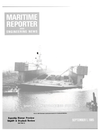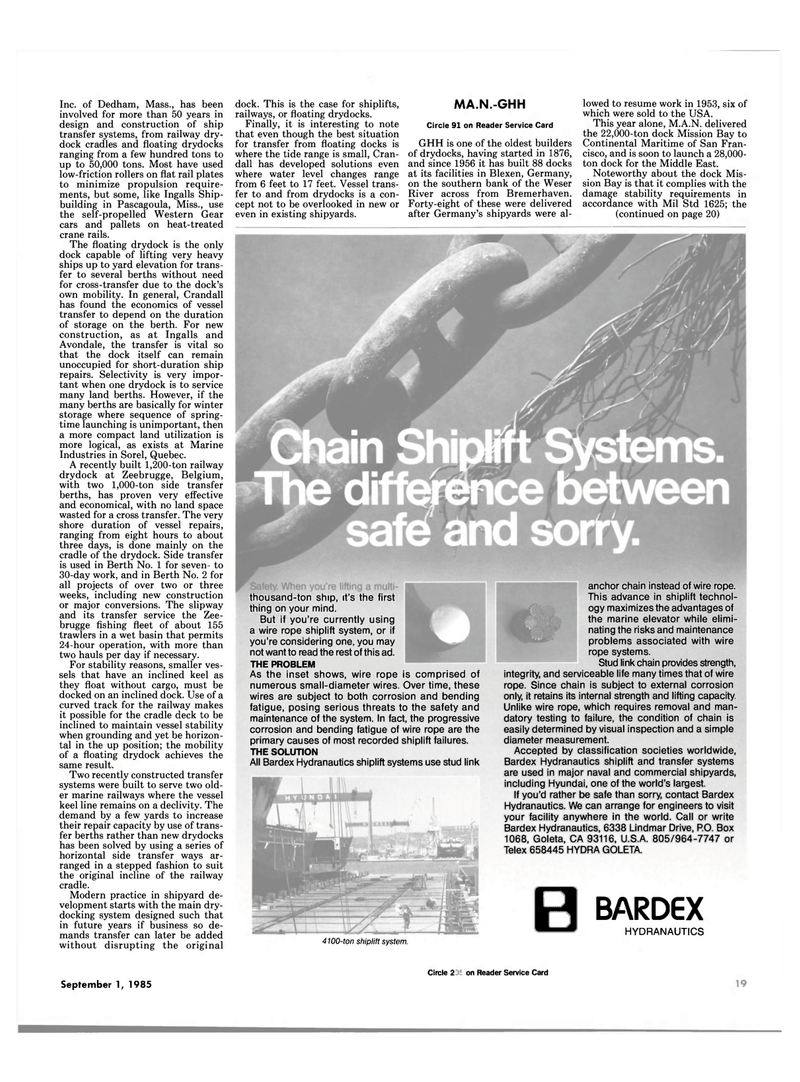
Page 17: of Maritime Reporter Magazine (September 1985)
Read this page in Pdf, Flash or Html5 edition of September 1985 Maritime Reporter Magazine
Inc. of Dedham, Mass., has been involved for more than 50 years in design and construction of ship transfer systems, from railway dry- dock cradles and floating drydocks ranging from a few hundred tons to up to 50,000 tons. Most have used low-friction rollers on flat rail plates to minimize propulsion require- ments, but some, like Ingalls Ship- building in Pascagoula, Miss., use the self-propelled Western Gear cars and pallets on heat-treated crane rails.
The floating drydock is the only dock capable of lifting very heavy ships up to yard elevation for trans- fer to several berths without need for cross-transfer due to the dock's own mobility. In general, Crandall has found the economics of vessel transfer to depend on the duration of storage on the berth. For new construction, as at Ingalls and
Avondale, the transfer is vital so that the dock itself can remain unoccupied for short-duration ship repairs. Selectivity is very impor- tant when one drydock is to service many land berths. However, if the many berths are basically for winter storage where sequence of spring- time launching is unimportant, then a more compact land utilization is more logical, as exists at Marine
Industries in Sorel, Quebec.
A recently built 1,200-ton railway drydock at Zeebrugge, Belgium, with two 1,000-ton side transfer berths, has proven very effective and economical, with no land space wasted for a cross transfer. The very shore duration of vessel repairs, ranging from eight hours to about three days, is done mainly on the cradle of the drydock. Side transfer is used in Berth No. 1 for seven- to 30-day work, and in Berth No. 2 for all projects of over two or three weeks, including new construction or major conversions. The slipway and its transfer service the Zee- brugge fishing fleet of about 155 trawlers in a wet basin that permits 24-hour operation, with more than two hauls per day if necessary.
For stability reasons, smaller ves- sels that have an inclined keel as they float without cargo, must be docked on an inclined dock. Use of a curved track for the railway makes it possible for the cradle deck to be inclined to maintain vessel stability when grounding and yet be horizon- tal in the up position; the mobility of a floating drydock achieves the same result.
Two recently constructed transfer systems were built to serve two old- er marine railways where the vessel keel line remains on a declivity. The demand by a few yards to increase their repair capacity by use of trans- fer berths rather than new drydocks has been solved by using a series of horizontal side transfer ways ar- ranged in a stepped fashion to suit the original incline of the railway cradle.
Modern practice in shipyard de- velopment starts with the main dry- docking system designed such that in future years if business so de- mands transfer can later be added without disrupting the original dock. This is the case for shiplifts, railways, or floating drydocks.
Finally, it is interesting to note that even though the best situation for transfer from floating docks is where the tide range is small, Cran- dall has developed solutions even where water level changes range from 6 feet to 17 feet. Vessel trans- fer to and from drydocks is a con- cept not to be overlooked in new or even in existing shipyards.
MA.N.-GHH
Circle 91 on Reader Service Card
GHH is one of the oldest builders of drydocks, having started in 1876, and since 1956 it has built 88 docks at its facilities in Blexen, Germany, on the southern bank of the Weser
River across from Bremerhaven.
Forty-eight of these were delivered after Germany's shipyards were al-
Circle 292 on Reader Service Card lowed to resume work in 1953, six of which were sold to the USA.
This year alone, M.A.N, delivered the 22,000-ton dock Mission Bay to
Continental Maritime of San Fran- cisco, and is soon to launch a 28,000- ton dock for the Middle East.
Noteworthy about the dock Mis- sion Bay is that it complies with the damage stability requirements in accordance with Mil Std 1625; the (continued on page 20)
B thousand-ton ship, it s the first thing on your mind.
But if you're currently using a wire rope shiplift system, or if you're considering one, you may not want to read the rest of this ad.
THE PROBLEM
As the inset shows, wire rope is comprised of numerous small-diameter wires. Over time, these wires are subject to both corrosion and bending fatigue, posing serious threats to the safety and maintenance of the system. In fact, the progressive corrosion and bending fatigue of wire rope are the primary causes of most recorded shiplift failures.
THE SOLUTION
All Bardex Hydranautics shiplift systems use stud link anchor chain instead of wire rope.
This advance in shiplift technol- ogy maximizes the advantages of the marine elevator while elimi- nating the risks and maintenance problems associated with wire rope systems.
Stud link chain provides strength, integrity, and serviceable life many times that of wire rope. Since chain is subject to external corrosion only, it retains its internal strength and lifting capacity.
Unlike wire rope, which requires removal and man- datory testing to failure, the condition of chain is easily determined by visual inspection and a simple diameter measurement.
Accepted by classification societies worldwide,
Bardex Hydranautics shiplift and transfer systems are used in major naval and commercial shipyards, including Hyundai, one of the world's largest.
If you'd rather be safe than sorry, contact Bardex
Hydranautics. We can arrange for engineers to visit your facility anywhere in the world. Call or write
Bardex Hydranautics, 6338 Lindmar Drive, P.O. Box 1068, Goleta, CA 93116, U.S.A. 805/964-7747 or
Telex 658445 HYDRA GOLETA. 4100-ton shiplift system.
BARDGX
HYDRANAUTICS
September 1, 1985 1 1

 16
16

 18
18
